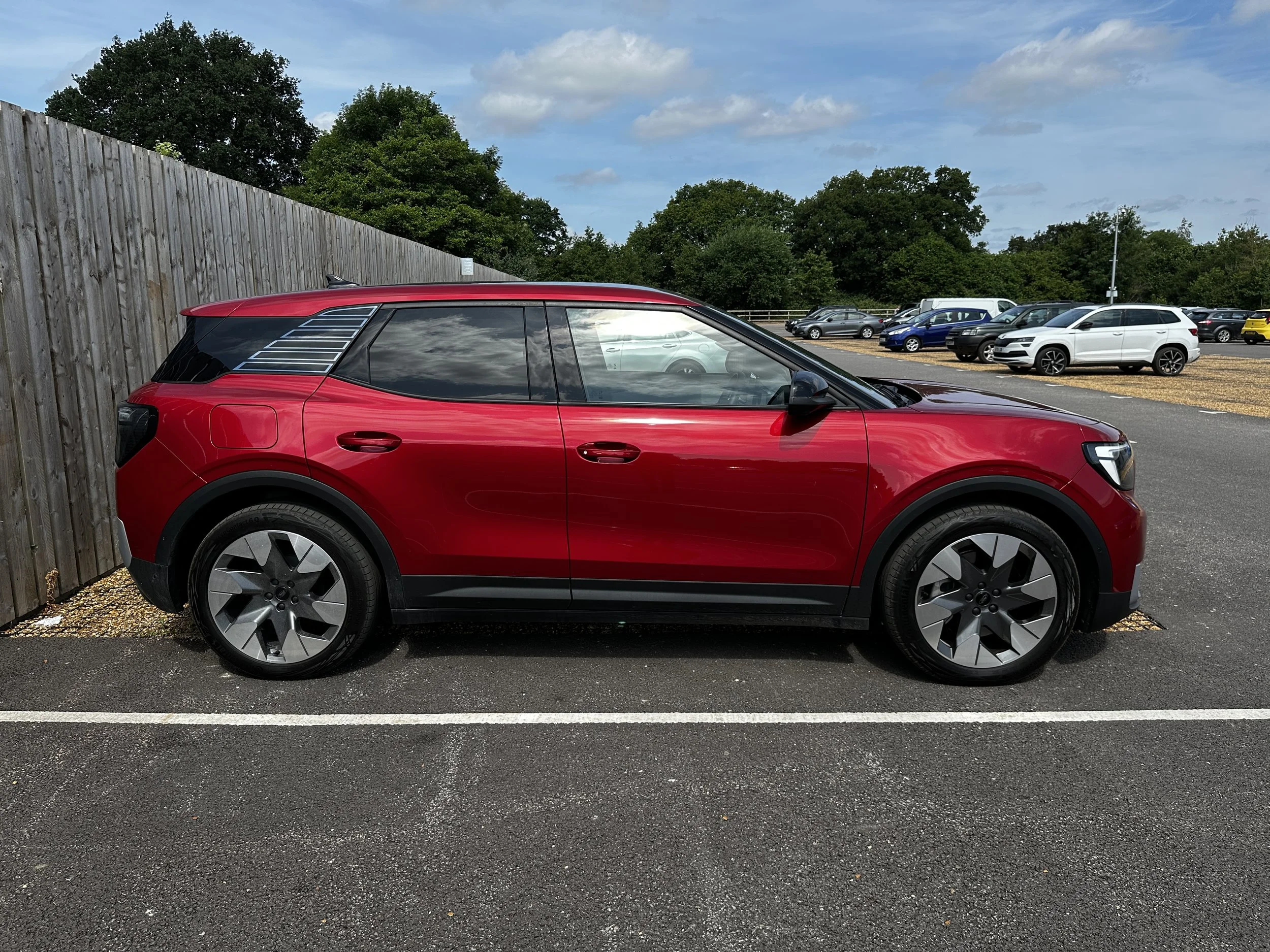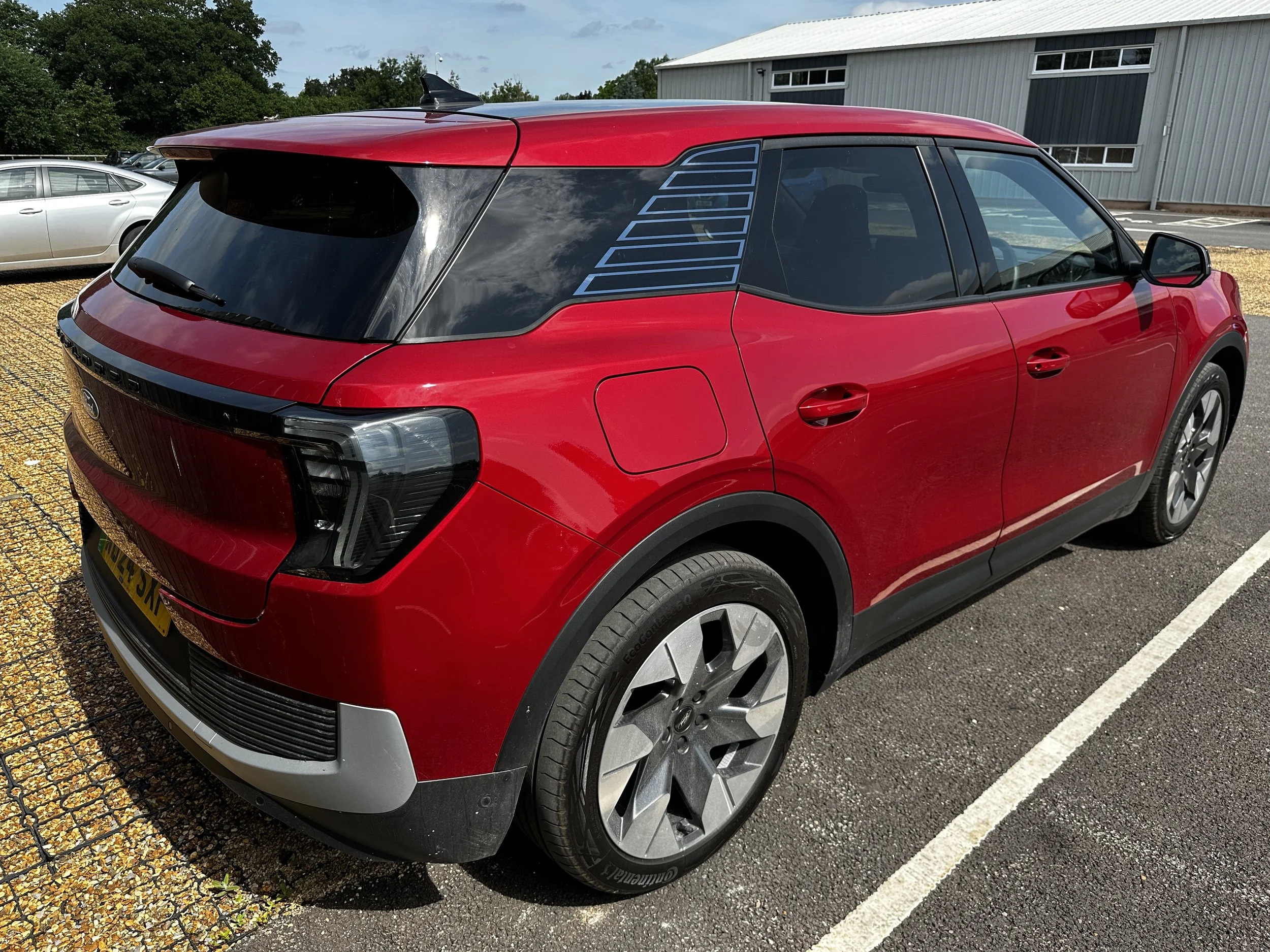
Ford Explorer
When is a Ford not a Ford? When it’s a Volkswagen.
The Ford Explorer sits in the middle of Ford’s EV lineup, above the Puma Gen-E and under the larger Mustang Mach-E. It is based on Volkswagen’s EV platform called MEB which puts it on the same underpinnings as the Capri, ID4, Enyaq and Q4 E-Tron.
Exterior
Ford has tried to differentiate the Explorer by giving the vehicle a boxier design. From the side, it’s a good-looking car with some interesting touches around the C-Pillar and rear. The 20” on this premium model fill out the arches nicely and don’t adversely affect the ride. There is the option of 21” wheels which are symmetrical if you’re a little OCD about that sort of thing but are a £1,000 option and will also make the ride firmer.
From the front head on, it can look a little jarring but the 3 quarter, side and rear profiles usefully distinguish it from other EVs. The short front and rear overhangs are helpful when parking and gives the Explorer and more stubby, bulky look.
Interior
Ford has gone for a 2-tone interior with the upper dash being black and the lower sections and portions of the door panel being a beige colour.
Materials wise, it’s a mixed bag. There are some nice, soft touch plastics in the areas you’re most likely to contact. The top of the dash and the lower panels are hard, scratchy plastics as are some the trim pieces in the doors.
The centre screen is a 14.6” vertical touchscreen that houses most of the controls and functions. It’s a responsive, app style user interface but can be slightly confusing when looking for certain functions such as the Bluetooth. The CarPlay works well when connected and supports Android Auto.
The screen itself is hinged to allow it to be adjusted from the vertical to a slanted position which covers an under-screen storage compartment. There may be concerns around the longevity of this hinge mechanism as its electrically released via button at the bottom which is easy to release mid adjustment. Also, glare is an issue with the screen in the slanted position as it can reflect an overhead sun right at a tall driver.
The buttons and switches for most of the interior controls are lifted from Volkswagen which can be fiddly to use. The light controls in the dash are capacitive touch but if set to Auto, become a non-issue. The window switch situation is, though. Say you want to wind down the rear window. There are only 2 switches in the door panel. So, you must look down at the switch to see if the REAR light is illuminated, if it isn’t then you need to long press it until it is. Theres no haptic feedback and your finger covers the word, so you need to glance down again. Then when it is, you can operate the respective window switch. Yes, you save 2 window switches per car but at the cost of annoyance to the driver.
Notable as well is the absence of a front boot. EVs built on tailor made platforms tend to have packaged the vehicle so there’s space up front for a small storage compartment. Ford has noticeable done this with the Mustang Mach-E which, before the fitment of a heat pump for 2025, had 100 litres of space. I believe this to space to be a useful addition when putting things such as dirty boots or smelly takeaway in rather than the cabin.
Driving
Around town, the Explorer behaves as most other SUVs would. The higher driving position is great for forward visibility and the large mirrors help with spatial awareness. The ride is comfortable with a firmer edge on the more potholed and rougher roads we have in the UK. Around bends, the car feels stable with predictable handling characteristics but it’s similarity to other cars on the same platform is obvious.
In the traffic light grand prix, the Explorer leaps away as any car with 335bhp should with near instantaneous response in sport mode. Sport mode also brings with it a useful amount of extra steering weight with ECO and Normal mode having exceptionally light steering.
On the motorway, the car is quiet, refined and comfortable. The car comes as standard with lane keep assist which will steer back into lane should it get too close to the white lines. The optional £1,300 driver assist pack adds: Keyless Entry with Door Handle Illumination, Windscreen Head-Up Display (HUD), Lane Centering with Lane Change Assist, Active Park Assist, 360-Degree Parking Camera and Hands-free Power-operated Tailgate. The HUD is clear and gives a good range of information while the lane centering is perfect for long, tiring motorway jaunts as it takes the effort out of the in-lane micro corrections.
One issue I experienced is the vehicle relies on GPS position for the speed limit warnings rather than using the camera to detect speed signs and adjust accordingly. On my drive I found I was driving through a 30mph zone with the HUD indicating it was a 40mph limit.
Both the Explorer and Capri miss out on one feature that is extremely useful: One pedal driving. This is in stark contrast to the EVs that Ford has designed from the ground up that do. In basic terms, one pedal driving allows the car to roll to a complete stop without touching the brakes. Not only does this ensure the maximum amount of energy is regenerated into the battery but makes town driving easier having to simply release the throttle to slow down.
The Explorer and Capri have the option of Drive and Braking mode (D/B mode on the gear selector) with drive offering very light regeneration and braking offering a stronger slowing force. Although at town speeds, this regen can still be weak leading to heavier use of the brakes.
Efficiency on the drive was 4.0 miles/kWh which would equate to a range of 316 miles on the 79kWh AWD model I was supplied with. This was a mix of town, motorway and some higher speed rural roads.
Charging
The Explorer comes with the ability to charge at up to 11kW AC if the chargepoint has 3 phase capability. This would charge the car between about 5.5 and 8.5 hours to recharge depending on the model. More common for homes and public charging is 7kW single phase which increases that time to between 8.5 and 13 hours respectively.
DC charging is between 145kW and 185kW depending on model which can do a 10-80% in under 30 minutes. What is a feature I think should be in all EVs is the ability to manually activate the battery pre-conditioning for the fastest charge possible. Some manufacturers will do it when navigating to a charger but it’s nice to just switch it on regardless. I believe this feature will become more widespread as the industry moves to LFP batteries because of their cold weather limitations.
FordPass App
With electrified vehicles, the app support is crucial for the functions and vehicle stats. They usually support lock/unlock, climate control, remaining range, and battery charging status. FordPass; however, you’d have better chance of reading tea leaves to understand what’s going on with the car. Random log outs, limited functionality, slow response when requesting an action. When it works, it’s okay but can be extremely frustrating having to rely upon other apps such as the home charger to see if the car is charging.
Final Thoughts
Options I would choose for the Explorer would be the Driver Assist pack as it has a lot of features that makes driving and parking easier. I would also specify the £1,050 heat pump system as this allows scavenging of heat from the battery and traction motor to warm the cabin instead of relying on a large resistive element.
The unfortunate situation for the Explorer is that the mid-size EV SUV market is extremely competitive and is getting more so as more Chinese manufacturers such as BYD and XPENG start selling vehicles in the UK. As the Explorer is based on the MEB platform, you instantly start comparing it to models on the same platform such as the VW ID4, Skoda Enyaq, and Audi Q4 E-Tron which it does stack up well against in some areas such as the central touchscreen and the looks inside and out. The central infotainment screen and particularly the climate controls are far easier to use than the ID4.
Prices for the Explorer start at £39,285. This will get you a range of 233 miles and 168bhp. This is roughly in line with the Enyaq and ID4 and some £8,000 less than a Q4 E-Tron.
Would I buy one? If I wanted an electric Ford then I would go for the larger, better looking Mustang Mach-E and if the Mach-E is too expensive then the Puma Gen-E actually has more storage inside, is more efficient, and starts at £29,995. The Capri might make more sense given its sportback styling but I have yet to test it.
If you’re after an Explorer or any other Ford EV model, check out Foray Ford Taunton. From personal experience, their sales and service departments are knowledgeable and friendly and their showroom has all the EV models available for you to check out. Thanks to them for use of this Explorer Premium AWD.
Overall: A room temperature egg and cress sandwich out of ten. You could… but not if there’s anything else available.






